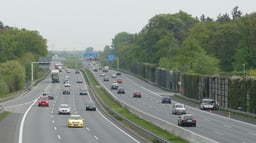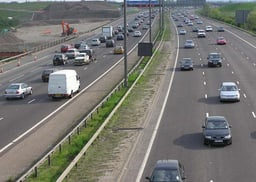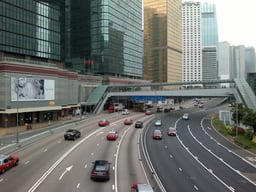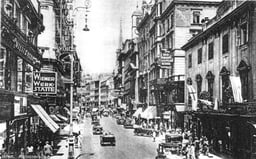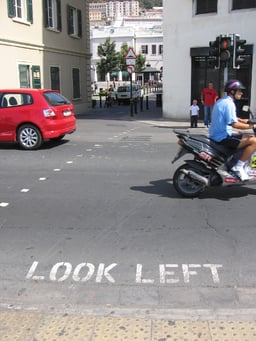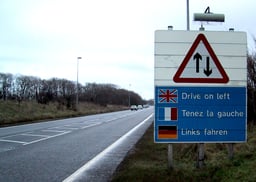Right- and left-hand traffic
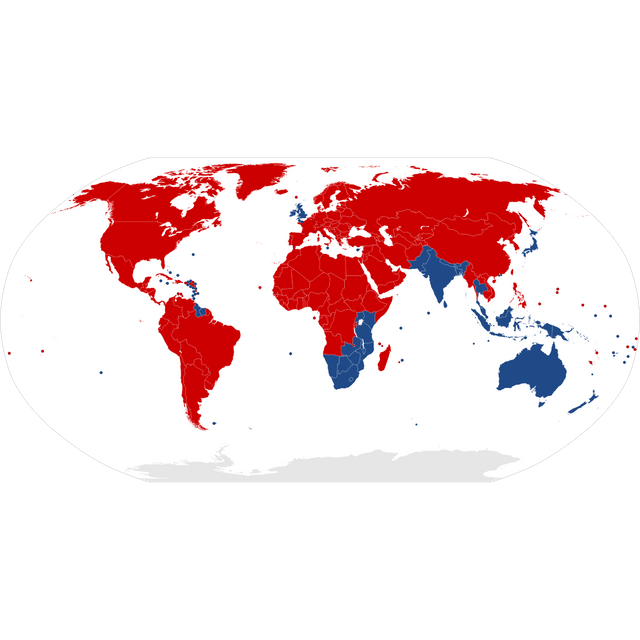
Right- and left-hand traffic

Boats are traditionally piloted from starboard to facilitate priority to the right
Left-hand traffic (LHT) and right-hand traffic (RHT) are the practice, in bidirectional traffic, of keeping to the left side or to the right side of the road, respectively. A fundamental element to traffic flow, it is sometimes referred to as the rule of the road.[1]
RHT is used in 165 countries and territories, with the remaining 75 countries and territories using LHT.[2] Countries that use LHT account for about a sixth of the world's area with about a third of its population and a quarter of its roads.[3] In 1919, 104 of the world's territories were LHT and an equal number were RHT. From 1919 to 1986, 34 of the LHT territories switched to RHT.[4]
Many LHT countries were formerly part of the British Empire, although some were not, such as Japan, Thailand, Indonesia, and Suriname. Conversely, many RHT countries were part of the French colonial empire.
For rail transport, LHT predominates in Western Europe (except Germany, Denmark, Austria, Spain, and the Netherlands), Latin America (except Mexico), and in countries formerly in the British and French Empires, whereas North American and central and eastern European train services operate RHT.
According to the International Regulations for Preventing Collisions at Sea, water traffic is effectively RHT: a vessel proceeding along a narrow channel must keep to starboard (the right-hand side), and when two power-driven vessels are meeting head-on both must alter course to starboard also. For aircraft the US Federal Aviation Regulations suggest RHT principles, both in the air and on water.[5]
In LHT vehicles keep left, and cars are RHD (right-hand drive) with the steering wheel on the right-hand side and the driver sitting on the offside or side closest to the center of the road. The passenger sits on the nearside, closest to the curb. Roundabouts circulate clockwise. In RHT everything is reversed: cars keep right, the driver sits on the left side of the car, and roundabouts circulate counterclockwise.
History
Europe

Border between Sweden and Norway in 1934
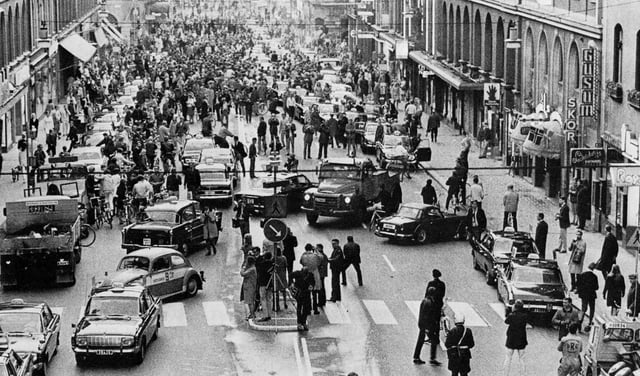
Traffic moves from left to right in Stockholm, Sweden, on 3 September 1967

A sign in Dublin Airport reminding visiting motorists to drive on the left
Ancient Greek, Egyptian, and Roman troops kept to the left when marching.[6] In 1998, archaeologists found a well-preserved double track leading to a Roman quarry near Swindon, in southern England. The grooves in the road were much deeper on the left side when facing away from the quarry than those on the right side. This suggests LHT at this location, since carts would exit the quarry heavily loaded and enter it empty.[7] In the year 1300, Pope Boniface VIII directed pilgrims to keep left.[6]
The first reference in English law to LHT was in 1756, with regard to London Bridge.[8]
After the French Revolution, all traffic in France kept right.[8]
Rotterdam was LHT until 1917,[9] although the rest of the Netherlands was RHT.
Russia completely switched to RHT in the last days of the Tsars in February 1917.
After the Austro-Hungarian Empire broke up, the resulting countries gradually changed to RHT. In Austria, Vorarlberg switched in 1921, North Tyrol in 1930, Carinthia and East Tyrol in 1935, and the rest of the country in 1938.[10] In Romania, Transylvania, the Banat and Bukovina were LHT until 1919, while Wallachia and Moldavia were already RHT. Partitions of Poland belonging to the German Empire and the Russian Empire were RHT, while the Austrian Partition changed in the 1920s[11] Croatia-Slavonia switched on joining the Kingdom of Yugoslavia in 1918, although Istria and Dalmatia were already RHT.[12] Nazi Germany introduced the switch in Czechoslovakia and Slovakia in 1938–1939.[13][14] West Ukraine was LHT, but the rest of Ukraine, having been part of the Russian Empire, was RHT.
In Italy, the countryside was RHT while cities were LHT until 1927.[15] Rome changed to RHT in 1924 and Milan in 1926. However, the Rome Metro, built in 1955, uses LHT. Alfa Romeo and Lancia produced RHD cars to special order until 1950 and 1953 respectively; many drivers preferred RHD even in RHT, as it offered the driver a clearer view of the edges of mountain roads that lacked barriers.[16]
Portugal switched to RHT in 1928.
Finland, formerly part of LHT Sweden, switched to RHT in 1858 as the Grand Duchy of Finland by Russian decree.[17]
Sweden switched to RHT in 1967. It was LHT from about 1734[18] despite having land borders with RHT countries, and approximately 90% of cars being left-hand drive (LHD).[19] A referendum in 1955 overwhelmingly rejected a change to RHT but years later the government ordered it, and it occurred on Sunday, 3 September 1967[20] at 5 am. The accident rate then dropped sharply,[21] but soon rose to near its original level.[22] The day was known as Högertrafikomläggningen or Dagen H for short. When Iceland switched the following year, it was known as Hægri dagurinn or H-dagurinn.[23] Most passenger cars in Iceland were already LHD.
The United Kingdom is LHT, but its overseas territories of Gibraltar and British Indian Ocean Territory are RHT. In the late 1960s, the UK Department for Transport considered switching to RHT, but declared it unsafe and too costly for such a built-up nation.[24] Road building standards, for motorways in particular, allow asymmetrically designed road junctions, where merge and diverge lanes differ in length.[25]
Today, four countries in Europe continue to use LHT, all island nations: the UK (including Northern Ireland), Cyprus, Republic of Ireland, and Malta.
Africa

Southern African Development Community LHT roundabout sign

RHT roundabout sign
Egypt was conquered by Napoleon and it kept RHT even after it became a British dependency.
LHT was introduced in British West Africa. All of the countries formerly part of this colony border with former French RHT jurisdictions and have switched to RHT since decolonization. These include Ghana, Gambia,[26] Sierra Leone, and Nigeria. Britain introduced LHT to the East Africa Protectorate (now Kenya, Tanzania and Uganda), Rhodesia, and the Cape Colony (now Zambia, Zimbabwe and South Africa). All of these have remained LHT. Sudan, formerly part of Anglo-Egyptian Sudan switched to RHT in 1973, as it is surrounded by neighbouring RHT countries.
The Portuguese Empire, then LHT, introduced LHT to Portuguese Mozambique and Portuguese Angola. Although Portugal itself switched to RHT in 1928, these territories remained LHT as they have land borders with former British colonies. Other former Portuguese colonies in Africa including Guinea-Bissau, São Tomé and Príncipe, and Cape Verde switched to RHT in 1928.
France introduced RHT in French West Africa and the Maghreb, where it is still used. Countries in this former colony include Mali, Mauritania, Ivory Coast, Burkina Faso, Benin, Niger, Morocco, Algeria, and Tunisia. Other French former colonies that are RHT include Cameroon, Central African Republic, Chad, Djibouti, Gabon, and the Republic of the Congo.
Rwanda and Burundi, former Belgian colonies in Central Africa, are RHT but are considering switching to LHT[27][28] like neighbouring members of the East African Community (EAC).[29] A survey in 2009 found that 54% of Rwandans favoured the switch. Reasons cited were the perceived lower costs of RHD vehicles, easier maintenance and the political benefit of harmonious traffic regulations with other EAC countries. The survey indicated that RHD cars were 16% to 49% cheaper than their LHD counterparts.[30] In 2014, an internal report by consultants to the Ministry of Infrastructure recommended a switch to LHT.[31] In 2015, the ban on RHD vehicles was lifted; RHD trucks from neighbouring countries cost $1000 less than LHD models imported from Europe.[32][33]
North America

Saint John, New Brunswick, circa 1898. Parts of Canada were LHT until the 1920s.
In what is now Canada, LHT was introduced by the British in British Columbia, which changed to RHT in stages from 1920 to 1923,[34][35] and New Brunswick, Nova Scotia, and Prince Edward Island, which changed in 1922, 1923, and 1924 respectively.[36] Newfoundland, then a British colony,[37] changed to RHT in 1947, two years before joining Canada.[38] Former parts of New France have always been RHT.[39]
In the early years of British colonisation of North America in 18th century, British driving customs were followed and the original 13 colonies drove on the left. After gaining independence from the United Kingdom in 4 July 1776, however, they were anxious to cast off all remaining links with their British colonial past and gradually changed to right-hand driving, influenced by a number of factors, including gratitude for French help in the War of Independence, the views of those Americans with roots in continental Europe and specifically the influence of General Lafayette, the French liberal reformer. Incidentally, the influence of other European immigrants, especially the French, should not be underestimated.
In the late 1700s, traffic in the United States was RHT based on teamsters' use of large freight wagons pulled by several pairs of horses. The wagons had no driver's seat, so the (typically right-handed) postilion held his whip in his right hand and thus sat on the left rear horse. Seated on the left, the driver preferred that other wagons pass him on the left so that he could be sure to keep clear of the wheels of oncoming wagons.[40] The first keep-right law for driving in the United States was passed in 1792 and applied to the Philadelphia and Lancaster Turnpike.[41] New York formalized RHT in 1804, New Jersey in 1813 and Massachusetts in 1821.[42] Today the United States is RHT except the United States Virgin Islands,[43] which is LHT like many neighboring islands.
Some postal service vehicles, garbage trucks, many parking enforcement vehicles and uncommon specialty vehicles in the United States are still being RHD.
In the West Indies, colonies and territories drive on the same side as their parent countries, except for the United States Virgin Islands. Many of the island nations are former British colonies and drive on the left, including Jamaica, Antigua and Barbuda, Barbados, Dominica, Grenada, Saint Kitts and Nevis, Saint Lucia, Saint Vincent and the Grenadines, Trinidad and Tobago, and The Bahamas.
Asia

Vehicles entering and leaving Macau cross over each other at the Lotus Bridge.
LHT was introduced by the British in British India (now India, Pakistan, Myanmar, and Bangladesh), British Malaya (now Malaysia, Brunei and Singapore), and British Hong Kong. All are still LHT except Myanmar, which switched to RHT in 1970,[44] although much of its infrastructure still geared to LHT. Most cars are used RHD vehicles imported from Japan.[45] Afghanistan was LHT until the 1950s, in line with neighbouring British India and later Pakistan.[46]
LHT was introduced by the Portuguese Empire in Portuguese Macau (now Macau) and Portuguese Timor (now East Timor). Both places are still LHT, despite Macau now being part of RHT China, requiring a right-to-left switching interchange at the Lotus Bridge which connects the two. East Timor shares the island of Timor with Indonesia, which is also LHT, although the former (then Portuguese Timor) switched to RHT along with Portugal in 1928[1] before changing back to LHT in 1976 during the Indonesian occupation of East Timor.
Both North Korea and South Korea switched to RHT in 1945 after liberation from Japanese colonial power.
The Philippines was mostly LHT during its Spanish[47] and American colonial periods,[48][49] as well as during the Commonwealth era.[50] During the Japanese occupation, the Philippines remained LHT,[51] also because LHT had been required by the Japanese;[52] but during the Battle of Manila, the liberating American forces drove their tanks to the right for easier facilitation of movement. RHT was formalised in 1945.[53]
Japan was never part of the British Empire, but its traffic also goes to the left. Although the origin of this habit goes back to the Edo period (1603-1868), it was not until 1872 that this unwritten rule became more or less official. That was the year when Japan’s first railway was introduced, built with technical aid from the British. Gradually, a massive network of railways and tram tracks was built, and of course all trains and trams drove on the left-hand side. Still, it took another half century till in 1924 left-side driving was clearly written in a law. In Japan, Post-World War II Okinawa was ruled by the United States Civil Administration of the Ryukyu Islands and was RHT. It was returned to Japan in 1972 but did not convert back to LHT until 1978.[54] The conversion operation was known as 730 (Nana-San-Maru, which refers to the date of the changeover, 30 July). Okinawa is one of few places to have changed from RHT to LHT in the late 1900s.
Vietnam became RHT as part of French Indochina, as did Cambodia. In the latter country, RHD cars, many of which were smuggled from Thailand, were banned from 2001, even though they accounted for 80% of vehicles in the country.[55]
Oceania
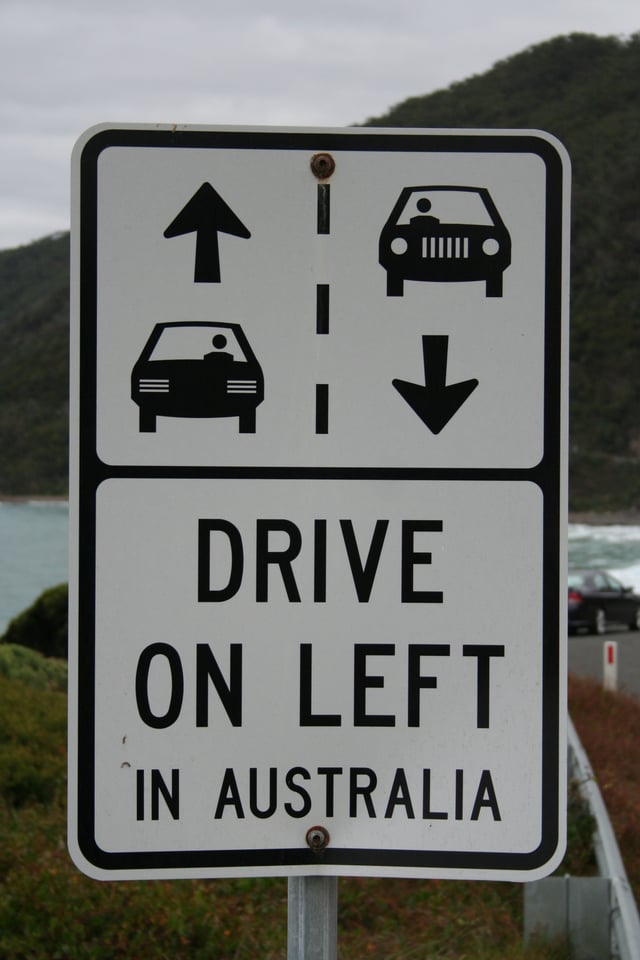
A sign reminding motorists to keep left in Australia.
Many former British colonies in the region have always been LHT, including Australia, New Zealand, Fiji, Kiribati, Solomon Islands, Tonga, and Tuvalu, as well as nations which were previously administered by Australia, being Nauru and Papua New Guinea.
Samoa, a former German colony, had been RHT for more than a century. It switched to LHT in 2009,[56] being the first territory in almost 30 years to switch.[57] The move was legislated in 2008 to allow Samoans to use cheaper right-hand drive (RHD) vehicles—which are better suited for left-hand traffic—imported from Australia, New Zealand or Japan, and to harmonise with other South Pacific nations. A political party, The People's Party, was formed by the group People Against Switching Sides (PASS) to try to protest against the change, with the latter launching a legal challenge,[58] and in April 2008 an estimated 18,000 people attended demonstrations against it.[59] The motor industry was also opposed, as 14,000 of Samoa's 18,000 vehicles are designed for RHT and the government has refused to meet the cost of conversion.[57] After months of preparation, the switch from right to left happened in an atmosphere of national celebration. There were no reported incidents.[3] At 05:50 local time, Monday 7 September, a radio announcement halted traffic, and an announcement at 6:00 ordered traffic to switch to LHT.[56] The change coincided with more restrictive enforcement of speeding and seat-belt laws.[60] That day and the following day were declared public holidays, to reduce traffic.[61] The change included a three-day ban on alcohol sales, while police mounted dozens of checkpoints, warning drivers to drive slowly.[3]
South America
Brazil was a colony of Portugal until the early 19th century and during this century and the early 20th century had mixed rules, with some regions still on LHT, switching these remaining regions to RHT in 1928, the same year Portugal switched sides.[62] Other Central and South American countries that later switched from LHT to RHT include Argentina, Chile, Panama,[63] Paraguay,[64] and Uruguay.
Suriname, along with neighbouring Guyana, are the only two remaining LHT countries in South America.[65]
Changing sides at borders

Traffic Switchover sign at the Thai–Lao Friendship Bridge
Although many LHT jurisdictions are on islands, there are cases where vehicles may be driven from LHT across a border into a RHT area. Such borders are mostly located in Africa and southern Asia. The Vienna Convention on Road Traffic regulates the use of foreign registered vehicles in the 74 countries that have ratified it.
LHT Thailand has three RHT neighbors: Cambodia, Laos, and Myanmar. Most of its borders use a simple traffic light to do the switch, but there are also interchanges which enable the switch while keeping up a continuous flow of traffic.[66]
There are four road border crossing points between Hong Kong and Mainland China. In 2006, the daily average number of vehicle trips recorded at Lok Ma Chau was 31,100.[67] The next largest is Man Kam To, where there is no changeover system and the border roads on the mainland side Wenjindu intersect as one-way streets with a main road.
The Takutu River Bridge (which links LHT Guyana and RHT Brazil[68]) is the only border in the Americas where traffic changes sides.
Although the United Kingdom is separated from Continental Europe by the English Channel, the level of cross-Channel traffic is very high; the Channel Tunnel alone carries 3.5 million vehicles per year by the Eurotunnel Shuttle between the UK and France.
Road vehicle configurations
Driver seating position
In RHT jurisdictions, vehicles are configured with LHD, with the driver sitting on the left side. In LHT jurisdictions, the reverse is true. The driver's side, the side closest to the centre of the road, is sometimes called the offside, while the passenger side, the side closest to the side of the road, is sometimes called the nearside.[69]
Most windshield wipers are designed to clear the driver's side better and have a longer blade on the driver's side[70] and wipe up from the passenger side to the driver's side. Thus on LHD configurations, they wipe up from right to left, viewed from inside the vehicle, and do the opposite on RHD vehicles.
Historically there was less consistency in the relationship of the position of the driver to the handedness of traffic. Most American cars produced before 1910 were RHD.[41] In 1908 Henry Ford standardised the Model T as LHD in RHT America,[41] arguing that with RHD and RHT, the passenger was obliged to "get out on the street side and walk around the car" and that with steering from the left, the driver "is able to see even the wheels of the other car and easily avoids danger."[71] By 1915 other manufacturers followed Ford's lead, due to the popularity of the Model T.[41]
In specialised cases, the driver will sit on the nearside, or kerbside. Examples include:
Where the driver needs a good view of the nearside, e.g. street sweepers, or vehicles driven along unstable road edges.[72]
Where it is more convenient for the driver to be on the nearside, e.g. delivery vehicles. The Grumman LLV postal delivery truck is widely used with RHD configurations in RHT North America. Some Unimogs are designed to switch between LHD and RHD to permit operators to work on the more convenient side of the truck.
Headlamps and other lighting equipment

Bird's-eye view of low beam light pattern for RH traffic, with long seeing range on the right and short cutoff on the left so oncoming drivers are not dazzled.
Most low-beam headlamps produce an asymmetrical light suitable for use on only one side of the road. Low beam headlamps in LHT jurisdictions throw most of their light forward-leftward; those for RHT throw most of their light forward-rightward, thus illuminating obstacles and road signs while minimising glare for oncoming traffic.
In Europe, headlamps approved for use on one side of the road must be adaptable to produce adequate illumination with controlled glare for temporarily driving on the other side of the road,[77] [] . This may be achieved by affixing masking strips or prismatic lenses to a part of the lens or by moving all or part of the headlamp optic so all or part of the beam is shifted or the asymmetrical portion is occluded.[77] [] Some varieties of the projector-type headlamp can be fully adjusted to produce a proper LHT or RHT beam by shifting a lever or other movable element in or on the lamp assembly.[77] [] Some vehicles adjust the headlamps automatically when the car's GPS detects that the vehicle has moved from LHT to RHT and vice versa.
Rear fog lamps
In the European Union, vehicles must be equipped with one or two red rear fog lamps. A single rear fog lamp must be located between the vehicle's longitudinal centreline and the outer extent of the driver's side of the vehicle.[78]
Crash testing differences
An Australian news source reports that some RHD cars imported to that country did not perform as well on crash tests as the LHD versions, although the cause is unknown, and may be due to differences in testing methodology.[79]
Rail traffic

Trains use right-hand track Trains use left-hand track Rail traffic is mixed or lacking
In most countries, rail traffic travels on the same side as road traffic. However, in many cases railways were built, often using LHT British technology, and road traffic switched to RHT while rail remained LHT. Examples include: Argentina, Belgium, Bolivia, Cambodia, Chile, Egypt, France, Iraq, Israel, Italy, Laos, Monaco, Myanmar, Nigeria, Peru, Portugal, Senegal, Slovenia, Sweden, Switzerland, Taiwan, Tunisia, Venezuela, and Yemen. In Indonesia it is the reverse (RHT for rails (even for LRT systems) and LHT for roads). France is mainly LHT for trains, except for the classic lines in Alsace-Lorraine[80] which belonged to Germany when the railways were built before 1918. China is basically LHT for long-distance trains and RHT for metro systems. Spain, which is RHT for railways has LHT for metros in Madrid and Bilbao. Metros and light rail sides of operation vary, and might not match railways or roads in their country. Trams generally operate at the same side as a road traffic due to a common sections with roads.
Worldwide distribution by country

Countries with left- and right-hand traffic, currently and formerly. Changes since 1858 when Finland changed to the right are taken into account. RHT Now RHT, formerly LHT LHT Now LHT, formerly RHT Formerly a mix of LHT and RHT in various parts of the country, now RHT
Of the 195 countries currently recognised by the United Nations, 141 use RHT and 54 use LHT on roads in general. A country and its territories and dependencies are counted as one. Whichever directionality is listed first is the type that is used in general in the traffic category.
| Country | Road traffic | Road switched sides | Notes, exceptions |
|---|---|---|---|
| RHT | |||
| RHT[81] | |||
| RHT[82] | French Algeria until 1962. | ||
| RHT[83] | Landlocked between France and Spain. | ||
| RHT[84] | 1928 | Portuguese colony until 1975. | |
| LHT[85] | British colony until 1958. Caribbean island. | ||
| RHT | 1945 | The anniversary on 10 June is still observed each year as Día de la Seguridad Vial (road safety day).[86] | |
| RHT[87] | |||
| LHT | British colonies before 1901. Continent is one nation. Includes Norfolk Island. | ||
| RHT | 1921–38 | ||
| RHT | |||
| LHT[65] | British colony before 1973. Caribbean island. | ||
| RHT | 1967 | Former British protectorate. Switched to same side as neighbours.[88] | |
| LHT | Part of British India before 1947. | ||
| LHT | British colony before 1966. Caribbean archipelagic state. | ||
| RHT | 1899[89] | ||
| RHT[90] | |||
| RHT | 1961[1] | Former British colony. Switched to same side as neighbours. | |
| RHT | Part of French West Africa before 1960. | ||
| LHT | Under British protection before 1949. | ||
| RHT | |||
| RHT | 1918 | Switched sides after the collapse of Austria-Hungary. | |
| LHT | |||
| RHT | 1928 | ||
| LHT | UK protection until 1984. | ||
| RHT | |||
| RHT | Part of French West Africa before 1958. | ||
| RHT | Belgian colony before 1962. | ||
| RHT | |||
| RHT | 1961 | ||
| RHT | 1920–24 | ||
| RHT | 1928 | Portuguese colony until 1975. | |
| RHT | French colony before 1960. | ||
| RHT | French colony before 1960. | ||
| RHT | 1920s | ||
| RHT/LHT | 1946 | RHT in the Mainland, whereas Hong Kong and Macau are LHT due to their colonial heritage. | |
| RHT | |||
| RHT | French colony before 1975. | ||
| RHT | French colony before 1960. | ||
| RHT | Belgian colony before 1960. | ||
| RHT | |||
| RHT | Part of French West Africa before 1960. | ||
| RHT | |||
| RHT | |||
| LHT | Under UK administration before 1960. Island nation. | ||
| RHT | 1939 | Switched during the German occupation of Czechoslovakia. | |
| RHT | Includes Faroe Islands and Greenland | ||
| RHT | |||
| LHT | British colony before 1978. Caribbean island. | ||
| RHT | |||
| LHT | 1976 | Portuguese colony until 1975. Switched to RHT with Portugal in 1928; under the Indonesian annexation, it was switched back to LHT in 1976. | |
| RHT | |||
| RHT | |||
| RHT | |||
| RHT | |||
| RHT | 1964 | Italian colony before 1942. | |
| RHT | |||
| LHT | Former British colony. Continues to drive on the same side as neighboring countries. | ||
| RHT | 1964 | ||
| LHT | British colony before 1970. Island nation. | ||
| RHT | 1858 | ||
| RHT | 1792 | Includes French Polynesia, New Caledonia, Saint Pierre and Miquelon, Wallis and Futuna, French Guiana, Réunion, Saint Barthélemy, Collectivity of Saint Martin, Guadeloupe, Mayotte. | |
| RHT | |||
| RHT | 1965 | British colony until 1965. Switched to RHT being surrounded by neighboring former French colonies. | |
| RHT | About 40% vehicles in Georgia are RHD due to the low cost of used cars imported from Japan.[91] | ||
| RHT[92] | |||
| RHT | 1974 | British colony until 1957. Ghana switched to RHT in 1974,[93][94] a Twi language slogan was "Nifa, Nifa Enan" or "Right, Right, Fourth".[95] Ghana has also banned RHD vehicles. Ghana prohibited new registrations of RHD vehicles after 1 August 1974, three days before the traffic change. | |
| RHT | |||
| LHT | British colony before 1974. Caribbean island. | ||
| RHT | |||
| RHT | |||
| RHT | 1928 | Portuguese colony until 1974. | |
| LHT | British colony until 1970. One of the few countries in continental Americas are in LHT. | ||
| RHT | |||
| RHT | Enclave of Rome. | ||
| RHT | |||
| RHT | 1941 | Originally LHT, like most of Austria-Hungary, but switched sides during the German occupation. | |
| RHT | 1968 | ||
| RHT | |||
| RHT | |||
| LHT | Part of British India before 1947. | ||
| LHT[96] | Roads and railways were built by the Dutch, with LHT for roads to conform to British and Japanese standards and RHT for railways. The Jakarta MRT and Palembang LRT also use RHT. | ||
| LHT | Part of the United Kingdom before 1922. | ||
| RHT | |||
| RHT | 1924–26 | ||
| LHT | British colony before 1962. Caribbean island. | ||
| LHT[97] | |||
| RHT | |||
| RHT | |||
| LHT[98] | Part of the British East Africa Protectorate before 1963. | ||
| LHT | UK colony before 1979. Pacific islands. | ||
| RHT | 1946 | Was LHT during the period of Japanese rule. Switched to RHT after Surrender of Japan. | |
| RHT | 1946 | ||
| RHT | |||
| RHT | |||
| RHT | In 2012, over 20,000 cheaper used RHD cars were imported from Japan.[99] | ||
| RHT | RHT implemented while part of French Indochina. | ||
| RHT | |||
| RHT | French Mandate of Lebanon before 1946. | ||
| LHT | Enclave of LHT South Africa. | ||
| RHT | |||
| RHT | Italian Libya colony from 1911 to 1947. | ||
| RHT | Landlocked between Switzerland and Austria. | ||
| RHT | |||
| RHT | |||
| RHT | Former French colony. | ||
| LHT | British colony before 1964. | ||
| LHT | British colony before 1957. | ||
| LHT | British colony before 1965. Island nation. | ||
| RHT | Part of French West Africa before 1960. | ||
| LHT | British colony before 1964. Island nation. | ||
| RHT | Was being under American control. | ||
| RHT | Part of French West Africa before 1960. Mining roads between Fderîck and Zouérat are LHT.[100] | ||
| LHT | British colony before 1968. Island nation. | ||
| RHT | |||
| RHT | Was being under American control. | ||
| RHT | |||
| RHT | Was under French control. | ||
| RHT | |||
| RHT | |||
| RHT | Former French colony. | ||
| LHT | Portuguese colony until 1975. | ||
| RHT | 1970 | Part of British India until 1948. Switched to RHT in 1970. | |
| RHT | 1906[101] | Includes Curaçao, Sint Maarten, and Aruba | |
| LHT | 1918 | Administered by South Africa 1920-1990. | |
| LHT | 1918 | Administered by Australia, New Zealand and the United Kingdom until 1968. Island nation. | |
| LHT | Lost the Anglo-Nepalese War with British India and shares land border with LHT India. | ||
| LHT[102] | British colony before 1947. Pacific island, including territories Niue and Cook Islands | ||
| RHT | |||
| RHT | Part of French West Africa before 1958. | ||
| RHT | 1972 | British colony until 1960. Switched to RHT being surrounded by neighboring former French colonies. | |
| RHT | |||
| RHT | |||
| RHT[103] | |||
| LHT | Part of British India before 1947. | ||
| RHT | |||
| RHT | |||
| RHT | 1943 | ||
| LHT | After Australia occupied German New Guinea during World War I, switched to LHT. | ||
| RHT | 1945 | ||
| RHT | |||
| RHT | 1946[53] | Was LHT during the Spanish and American colonial periods. Switched to RHT during Battle of Manila in 1945. Philippine National Railways switched to RHT in 2010. | |
| RHT | |||
| RHT[96] | 1928 | Colonies Goa, Macau and Mozambique, which had land borders with LHT countries, did not switch and continue to drive on the left.[104] The Porto Metro uses RHT. | |
| RHT | Former British protectorate. Switched to same side as neighbours. | ||
| RHT | 1919 | Parts of Romania formerly belonged to Austria-Hungary were LHT until 1919. | |
| RHT | In the Russian Far East RHD vehicles are common due to the import of used cars from nearby Japan.[105] Railway between Moscow and Ryazan, Sormovskaya line in Nizhny Novgorod Metro and Moskva River cable car use LHT. | ||
| RHT[27] | |||
| LHT | British colony before 1967. Caribbean island. | ||
| LHT | British colony before 1979. Caribbean island. | ||
| LHT | British colony before 1979. Caribbean island. | ||
| LHT | 2009 | Switched to LHT to allow for cheaper importation of cars from Australia, New Zealand and Japan.[96] | |
| RHT | Enclaved state surrounded by Italy. | ||
| RHT | 1928 | Portuguese colony until 1975. | |
| RHT | 1942 | ||
| RHT | Part of French West Africa before 1960. | ||
| RHT | Vojvodina was LHT while part of Austria-Hungary. | ||
| LHT | British colony before 1976. Island nation. | ||
| RHT | 1971[106] | British colony until 1961. Switched to RHT being surrounded by neighboring former French colonies. Banned the importation of RHD vehicles in 2013.[107] | |
| LHT | British colony until 1963 and was part of Malaysia until 1965. | ||
| RHT | 1939–41 | Switched during the German occupation of Czechoslovakia. | |
| RHT | |||
| LHT | British colony before 1975. Island nation. | ||
| RHT | The former British Somaliland had LHT until it formed a union with the former Italian Somaliland which had RHT. | ||
| LHT[108][109] | British colony before 1909. | ||
| RHT | 1973 | Former part of Anglo-Egyptian Sudan. | |
| RHT | 1924 | Up to the 1920s Barcelona was RHT, and Madrid was LHT until 1924. The Madrid Metro still uses LHT. | |
| LHT | British Ceylon 1815-1948. | ||
| RHT | 1973 | ||
| LHT | 1920s | Dutch colony until 1975. One of the few countries in continental Americas are in LHT. | |
| RHT | 1967 (3 September) | The day of the switch was known as Dagen H. Most passenger cars were already LHD. | |
| RHT | |||
| RHT | Was under French and Italian control. | ||
| RHT | 1946 | Was LHT during the period of Japanese rule. The government of the Republic of China changed Taiwan to RHT in 1946 along with the rest of China.[110] | |
| RHT | |||
| LHT | Part of the British East Africa Protectorate until 1961. | ||
| LHT[96] | One of the few LHT countries not a former British colony. Shares long land border with RHT Laos and Cambodia. | ||
| RHT | |||
| LHT | British protectorate before 1970. Polynesian island nation. | ||
| LHT[111] | British colony before 1962. Caribbean island. | ||
| RHT | French RHT was enforced in the French protectorate of Tunisia from 1881. | ||
| RHT | 1920s | ||
| RHT | |||
| LHT | British colony before 1974. Island nation. | ||
| LHT | British Uganda Protectorate 1894-1962. | ||
| RHT | 1922[11] | ||
| RHT | Former British protectorate. Switched to same side as neighbours. | ||
| LHT/RHT | 1929 (in Gibraltar) | Includes Crown dependencies and Overseas Territories Isle of Man, Guernsey, Jersey, Anguilla, Bermuda, British Virgin Islands, Cayman Islands, Falkland Islands, Montserrat, Pitcairn Islands (unregistered), Turks and Caicos Islands, Saint Helena, Ascension, Tristan da Cunha are all LHT. Gibraltar has been RHT since 1929 because of its land border with Spain.[112] The British Indian Ocean Territory is the only other overseas territory driving on the right. The Channel Islands (Jersey and Guernsey) drove on the right under German occupation lasting from 1940 to 1945.[113] | |
| RHT/LHT | U.S. Virgin Islands, like much of the Caribbean, is LHT and is the only American jurisdiction that still has LHT, because the islands drove on the left when the US purchased the former Danish West Indies in the 1917 Treaty of the Danish West Indies. | ||
| RHT | 1945 | Became LHT in 1918, but as in some other countries in South America, changed to RHT on 2 September 1945.[114] A speed limit of 30 km/h (19 mph) was observed until 30 September for safety. | |
| RHT | |||
| RHT[115] | Co-administrated under France and United Kingdom until 1980. | ||
| RHT | |||
| RHT | Became RHT as French Indochina. The Long Bien Bridge uses LHT. | ||
| RHT | Occupied by Spain until the late 1900s. | ||
| RHT | 1977[1] | South Yemen, formerly the British colony of Aden, changed to RHT in 1977. A series of postage stamps commemorating the event was issued.[116] North Yemen was already RHT. | |
| LHT | British colony before 1964. | ||
| LHT | British colony before 1965. |





